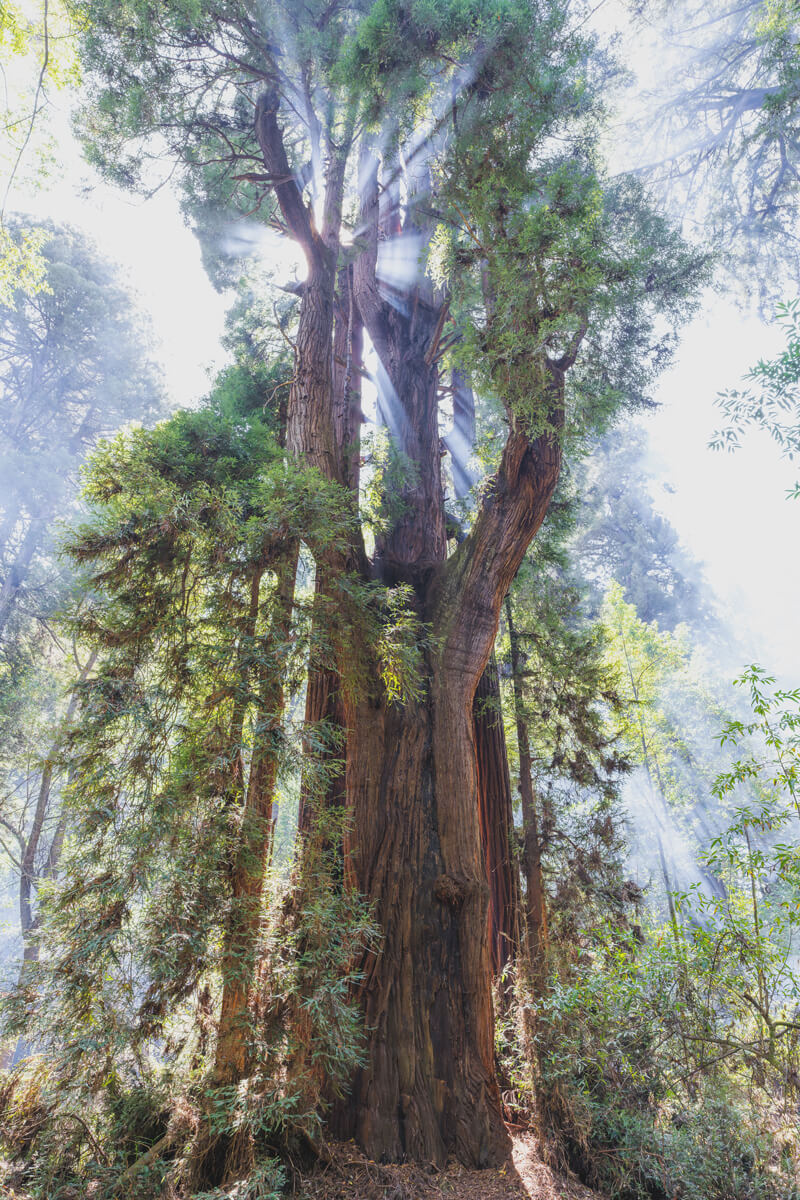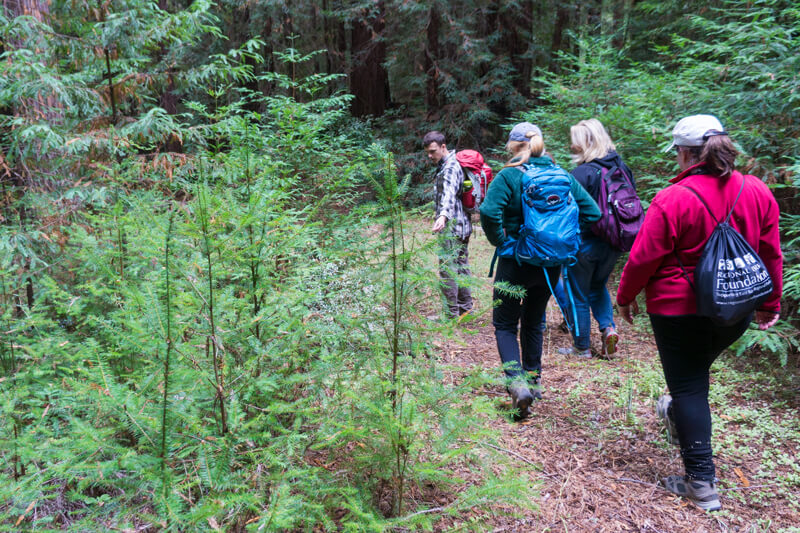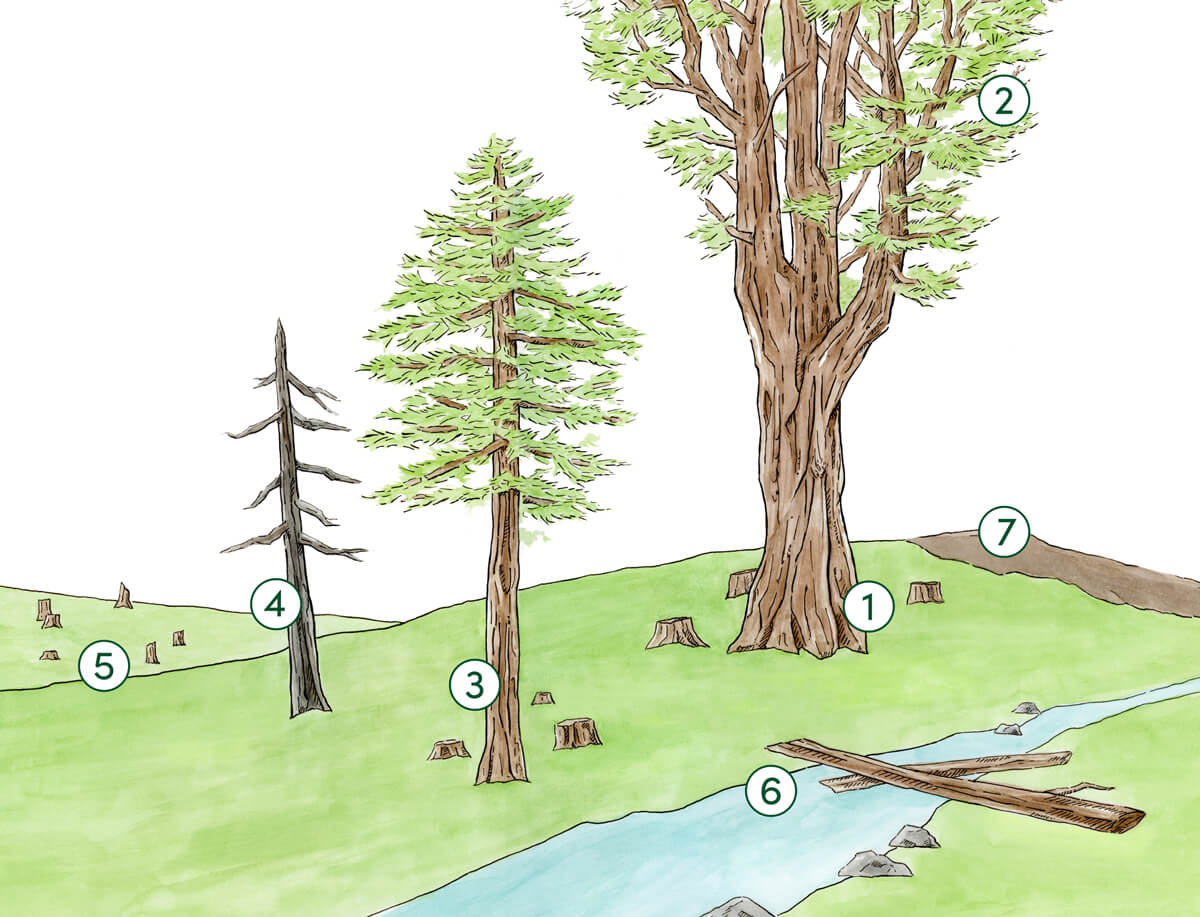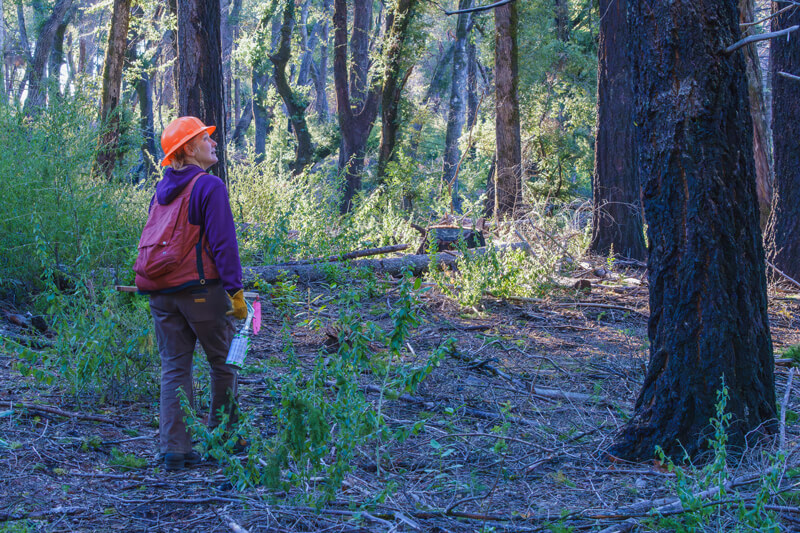Growing Old-Growth
photo by Orenda Randuch
The Benefits of Old-Growth
Seeing an ancient coast redwood in person is awesome. Capable of reaching heights more than three hundred feet tall–taller than the Statue of Liberty–redwoods are providing both habitat and unparalleled carbon storage every inch of the way. As redwoods grow older, typically about 150 years old in ideal habitat conditions, they not only grow taller, they also grow wider, thicker, and reiterate their trunks–creating lots of space for Co2 on the inside and space for wildlife and plants on the outside.
As they age, redwoods also become more resilient: better able to protect themselves and support the forest. Their thick, armor-like bark can grow to be a foot thick–helping to protect them from fire, pests, and rot. Old-growth canopies are higher and harder for fire to reach. Their well-established root systems spread 100-feet wide and interconnect with fungi and other trees throughout the forest to share nutrients and information. Old-growth redwoods are able to help support the forest as a whole, and with their ancient lifespans they are able to live for millennia. Read more facts about Redwoods.
Old-growth redwoods are not only crucial for forest health, they are crucial for the fight against climate change and species’ survival.

photo by Orenda Randuch
The Changing Forest
Redwoods’ size and resilience also made them incredibly desirable as building materials. The redwoods in the Santa Cruz Mountains were being clear cut to build, and rebuild when disasters like the 1906 earthquake struck, the growing communities around them. While your fellow supporters formed Sempervirens Fund in 1900 to protect the remaining redwood forests, many forests were already reduced to stumps. Only 5% or less old-growth redwoods are estimated to remain throughout their entire range today. While redwoods are incredibly resilient and capable of resprouting, entire forests were growing back at the same time which created forests that were too close together to grow as large as they once were and without many of the benefits of old-growth to help support them.
Redwoods at Big Basin show resilience 5 years after CZU Fire, story by CBS News Bay Area
Today, clear cut logging is not allowed in the Santa Cruz Mountains. But the forests, struggling to grow back in tight quarters without the assistance of their elders, face the additional challenges of increased droughts, high temperatures, and fire. When the 2020 CZU Fire ignited across the Santa Cruz Mountains, forests were already at a disadvantage–close together, hot, and dry. The unprecedented fire tore through 86,000 acres including nearly every protected acre Sempervirens Fund cares for. While most of the redwoods are expected to recover from the fire, the urgency to make forests as resilient as possible for the increasingly extreme and unpredictable effects of climate change ahead was starkly underscored.
Fortunately, Sempervirens Fund had decades of experience resetting redwood forests from past damage utilizing a forest management approach called Restoration Forestry. Active restoration forestry techniques had helped redwood forests recuperate more quickly and they could help establish healthy forest conditions like old-growth redwoods in decades rather than centuries
Restoration Forestry
Restoration forestry can help reset forest health and resilience so forests can provide fresh air, clean water, habitat, and carbon storage. Despite being backed by both cutting-edge science and traditional Indigenous practices, the methods can seem antithetical to their goals at first–after all, wasn't it cutting and fire that got the forest into this state in the first place?–but armed with research, humility, and observation, the results are becoming clearer and reinforce the need for our active management of forests.
When Sempervirens Fund protected a former tree farm in 2008, once known as Sempervirens 236, it was clear the forest near Boulder Creek would need more restoration forestry than any property we had protected before, in order to help return the industrial rows of trees back into a healthy, diverse, resilient forest. With the guidance of professionals like Forester Nadia Hamey, a plan was put in place to reduce competition and potential fuel for a fire, and increase the growth of larger redwoods, known as old-growth recruitment, and improve the forest’s resilience to challenges like fires and droughts. By 2019, we were already seeing an increase in biodiversity on the forest floor–a sign the forest can support more species. In 2023, Sempervirens 236’s redwood forests, now healthy and thriving, were added to Castle Rock State Park.
While a redwood forest might be able to restore itself given centuries and ideal conditions, the threats of climate change are unpredictable and urgent. Through restoration forestry techniques, forests like those at Sempervirens 236 can recover from the past and be resilient for the future more quickly.

photo by Rebecca Thomas
Forestry Techniques

illustrations by Shirley Chambers
1. Old Growth Recruitment
A restoration forestry technique removing smaller trees too close to a larger tree (sometimes called an “old growth candidate tree”) to increase the tree's growth and resilience by reducing competition and fuel.
2. Crown Release
A restoration forestry technique removing smaller trees too close to a larger tree to increase the tree's growth and resilience by reducing competition and fuel.
3. Thinning
A restoration forestry technique removing smaller trees that are too dense to reduce density, competition, and fuel.
4. Hazard Tree Removal
A forestry technique removing dead or damaged trees in danger of falling on life, structures, or access routes.
5. Clear Cut Logging
A forestry technique, outlawed in the Santa Cruz Mountains region in the 1970s, logging all trees within an area at the same time often leaving only stumps and disturbed soil.
6. Large Woody Debris
A restoration forestry technique strategically placing trees or large limbs into the water to mimic natural conditions that provide crucial water habitat for fish, water quality, and natural floodplains to reduce flooding downstream.
7. Fuel Breaks
A restoration forestry technique removing fast burning plants and trees from strategic areas like ridgelines to slow the spread of fire and increase firefighting opportunities.
The Living Laboratory
Restoration Forestry techniques like these are now helping the largest private forest remaining in the Santa Cruz Mountains recover from a history of logging, mining, and the severe 2020 CZU Fire, and regain resiliency as quickly as possible so the forest can both survive and help fight climate change. In the forests of San Vicente Redwoods that humans have exploited for nearly a century, we’re attempting to strike a careful balance of human involvement.

photo by Orenda Randuch
“Restoration at scale was always going to be tricky,” says Sempervirens Fund’s Executive Director Sara Barth. San Vicente Redwoods is a living laboratory where we seek to enhance its health by applying insights from academic research, other conservation organizations (including Peninsula Open Space Trust, Save the Redwoods League, and Land Trust Santa Cruz County), and the restoration forestry practices that helped reset Sempervirens 236 on a healthy trajectory for recovery. “Having a restoration and working forest in tandem has taught us a lot about not only supporting the forest’s long-term health but also how to prepare for and respond to wildfire.”
Protected in 2011, San Vicente Redwoods vast 8,532 acres include different plant communities, topographies, and different needs for recovery. Forester Nadia Hamey helped to prioritize the needs of the forest into different sections: Preservation - where the forest needs maintenance to stay healthy; Restoration - where the forest benefits from strategic thinning so trees can grow larger; and Working Forest - where the Old-Growth Recruitment helps redwoods gain much needed old-growth characteristics more quickly.
Any trees that are strategically cut for the forest’s health further benefit the forest by being utilized for habitat on the forest floor or in creeks, processed into biomass to return nutrients to the soil without the risk of becoming fuel for fire, or sold as lumber and reinvested into further work to restore San Vicente Redwoods.
Experts Dig into the Controversy
Restoration forestry and relying on sustainable logging to help fund conservation of San Vicente Redwoods has been controversial and it remains complicated today, even for its advocates. That includes Hamey. Logging can be done well or poorly, just like many other resource management objectives. When done well, it provides a sustainable source of wood with little long-term impact to the forest ecosystem,” she said. “We can use the revenue from timber harvesting to help achieve other land management objectives, like weed control, road maintenance, fuel reduction, large woody debris installation, etc.”
Dan Sicular, a California environmental planning consultant with 35 years of experience, believes that selling the logs harvested through thinning can help to fund forest restoration work, though he knows this view is controversial. His view acknowledges the reality of the outsized role of the timber economy in the West today; California’s forest industry contributes $39 billion to the state’s economy. With logging companies owning some of the largest tracts of land in the Santa Cruz Mountains, “I see some conservation benefit from having an active logging industry,” Sicular argued, especially when the alternative is for the companies to subdivide the parcels and sell them off, fragmenting crucial habitats. Also, since the logging companies don’t want their investments to burn up, they have a strong incentive to manage their land to prevent and control wildfire.
video by Jordan Plotsky
Tim Hyland, an environmental scientist for California State Parks, argues that in the Santa Cruz Mountains, the problem today is that there are too many trees, since forest managers stopped using fire to thin their ranks, especially fire-sensitive species like the Douglas fir. “So much damage to these ecosystems has happened in the last 100 to 200 years that it’s very easy for people to feel like, ‘please don’t touch it and it'll be fine.’”
Hyland acknowledged that, left alone for hundreds of years, the forest might eventually recover its state prior to Euro-American settlement, with one large tree out-competing the others to create a forest of giant redwoods that are widely-spaced from one another. But in a warming, drying climate, the smaller trees now crowding the understory are more susceptible to catastrophic, high-severity fires that leave significant damage. “A whole bunch of little sticks burn a lot better than one great big stick,” he explained. And since California forest managers have kept fire largely at bay for over a century, “lighting a fire in them is like playing with matches in a dynamite factory,” he said. “The fuels have built up to a point where it's extremely challenging to introduce fire in a safe way.” In this scenario, mechanical thinning of the smaller trees—cutting them, in other words—is a necessary safety measure before conducting prescribed burns.
video by Jordan Plotsky
Even while acknowledging that some trees must be cut down, Hyland remains skeptical. Felling the trees and dragging them out of the forest kicks up dust, disturbs the environment, and risks introducing invasive plants through the heavy equipment. “My primary problem with it is that humans are at the helm,” he said, “and if the decisions are influenced by financial considerations, then they're not primarily influenced by what the land needs.”
At San Vicente Redwoods, restoration forestry has been practiced with a lot of humility, evaluation, and a willingness to adjust if tactics aren’t working. Results of work done before the CZU Fire are incredibly encouraging and provide insight into where and how restoration forestry can help the forest recover from that fire and help protect it and nearby communities for the next fire.
Results for Redwoods
In February 2020–just a few months before thousands of lightning strikes ignited the CZU Fire in August 2020, crucial restoration forestry work took place that both helped protect the forest and nearby communities. Thirty acres in San Vicente Redwoods’ Restoration Reserve forest section were treated using prescribed and cultural burns, and more than 15 miles of shaded fuel breaks were created. The areas with prescribed burns appear to have weathered the blaze much better than the adjacent untreated parts of the forest. And the shaded fuel break helped fire crews stop the fire from spreading to a nearby community.
A photo of blackened tree trunks with healthy green canopies intact above was treated with a shaded fuel break prior to the CZU Fire and burned less severely. A photo of mostly standing dead trees with only a handful of trees bearing green regrowth and much more dense understory growth along the ground was not treated with a shaded fuel break prior to the CZU Fire and burned more severely. Photos taken in 2023 by Ian Bornarth.
“We’re seeing results that indicate restoration forestry are these redwood forests' best chance of recovering from past damage and both surviving and fighting climate change,” said Barth. Restoration Forestry is a key component to Sempervirens Fund’s Climate Action Plan, a plan to accelerate the protection and resilience of redwoods by 2030.
Redwood Recovery
In Real Time
You can witness redwood fire recovery first hand and catch a glimpse of a future old-growth redwood from the public trails at San Vicente Redwoods. Thank you for helping to protect and restore its vast forests, waterways, and habitats today, for tomorrow!
More to Explore
- Read more about restoration forestry in Why Cut Redwoods by Audrea Lim and Bay Nature magazine
- See the post-fire challenges at San Vicente Redwoods with Fuel for Fire
- Dig into post-fire research and Indigenous Stewardship at San Vicente Redwoods
- Watch the Awakening of the Silent Forest in the years after the CZU Fire